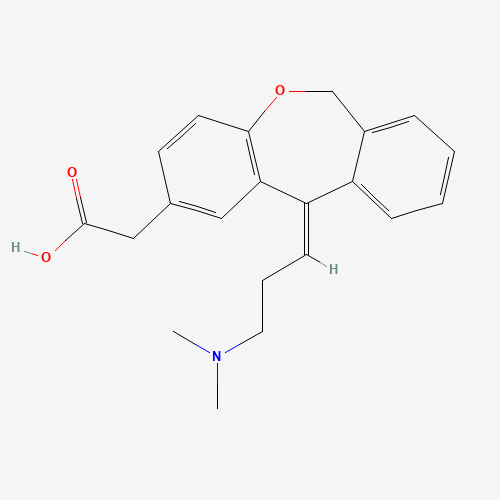| Pharmaceutical Information |
| Drug Name |
Olopatadine |
| Drug ID |
BADD_D01605 |
| Description |
Olopatadine is a selective histamine H1 antagonist and mast cell stabilizer that works by attenuating inflammatory and allergic reactions. It is a structural analog of [doxepin], which has a minimal anti-allergic activity.[L6790] Olopatadine works by blocking the effects of histamine, which is a primary inflammatory mediator that causes inflammatory and allergic reactions. An ophthalmic solution of olopatadine was approved by the FDA and European Union for the treatment of seasonal and perennial allergic conjunctivitis in 1996 and 2002, respectively.[A1172] In comparison to other anti-allergenic ophthalmic medications, olopatadine displays a good comfort and tolerability profile since it does not cause perturbation of cell membranes.[A179809] Olopatadine is used for the symptomatic treatment of ocular itching associated with allergic conjunctivitis in ophthalmic formulations and seasonal allergic rhinitis in intranasal formulations. It is currently marketed under several brand names, including Pazeo, Patanase, and Opatanol. |
| Indications and Usage |
Olopatadine is indicated for the symptomatic treatment of ocular itching associated with allergic conjunctivitis as ophthalmic solution.[L6781]
In nasal spray, olopatadine is indicated for the symptomatic relief of seasonal allergic rhinitis in patients 12 years of age and older.[L6784] |
| Marketing Status |
approved |
| ATC Code |
R01AC08; S01GX09 |
| DrugBank ID |
DB00768
|
| KEGG ID |
D08293
|
| MeSH ID |
D000069605
|
| PubChem ID |
5281071
|
| TTD Drug ID |
D05GPO
|
| NDC Product Code |
Not Available |
| UNII |
D27V6190PM
|
| Synonyms |
Olopatadine Hydrochloride | Hydrochloride, Olopatadine | KW-4943A | KW 4943A | KW4943A | Olopatadine | 11-(3-(dimethylamino)propylidene)-6,11-dihydrodibenz(b,e)oxepin-2-acetic acid | KW 4679 | 4679, KW | KW-4679 | Patanol |
|
| Chemical Information |
| Molecular Formula |
C21H23NO3 |
| CAS Registry Number |
113806-05-6 |
| SMILES |
CN(C)CCC=C1C2=CC=CC=C2COC3=C1C=C(C=C3)CC(=O)O |
| Chemical Structure |

|
|
| ADRs Induced by Drug |
|
|
*The priority for ADR severity classification is based on FAERS assessment, followed by the most severe level in CTCAE rating. If neither is available, it will be displayed as 'Not available'.
**The 'Not Available' level is hidden by default and can be restored by clicking on the legend twice..
|
|
|

